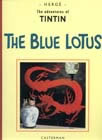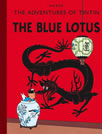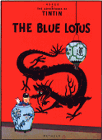The Blue Lotus

- Black & white facsimile / original version. Hardback.

- Colour facsimile / 1946 updated version. Hardback.

- Colour / 1946 updated version
- Tintin © Hergé/Moulinsart.
Original French title
Tintin en Extreme-Orient (serialised comic strip) / Le Lotus Bleu (album)
Publication history
First published in Le Petit Vingtième between 9/8 1934 and 17/10 1935. Published in book form in 1936 (B/W 124 pages). An edited edition in full colour was published in 1946 with the first four pages totally redrawn and minor changes made to the rest of the book.
English edition
1983 - Methuen Children's (London). Translated by Leslie Lonsdale-Cooper and Michael Turner. Colour. 62p. 31cm. ISBN: 0416444601.
1984 - Magnet (London). Translated by Leslie Lonsdale-Cooper and Michael Turner. Colour. 62p. 30cm. Paperback. ISBN: 0416494900.
1990 - Mammoth (London). Translated by Leslie Lonsdale-Cooper and Michael Turner. Colour. 62p. 30cm. Paperback. ISBN: 0749704659.
2006 - Casterman (Bruxelles). Translated by Leslie Lonsdale-Cooper and Michael Turner. Black and white facsimile. Hardback. ISBN: 2203707045.
2008 - Egmont (London). Colour facsimile. 64p. 300x230mm. ISBN: 9781405240703. (Publication date: 7 July 2008.)
Related link
First publication dates of The Adventures of Tintin
Review
Le Lotus Bleu was the most important album Hergé had created up to this point, and it remains one of the most important albums throughout the Tintin series. With this album Hergé's graphical development reaches its first peak, turning Tintin into the Tintin we now know. Hergé had already made clear that he intended to let Tintin travel to China in Le Petit Vingtième. Fearing that he would again fail to put down a true image for the setting and the (secondary) characters in his comic, Abbot Gosset, counsellor for a group of Chinese students in Leuven (Louvain, Belgium), wrote him a letter, asking him to do some research on his subject. The Abbot directed him to a Chinese student at the Académie de Bruxelles (Academy of Arts), Chang Chong-ren. The encounter that followed would change Hergé's life and art considerably.
From Chang, Hergé learned how to paint and draw according to Chinese techniques; it was Chang who told him about 'la ligne claire' (clear line), and who taught him how to paint Chinese characters. Chang told Hergé about life in China - the real China, not China as Hergé had drawn her in Tintin au pays des Soviets.
The impact Chang had on Hergé can hardly be overestimated, and it wasn't a big surprise that the two men became friends for life. A lot of what happens in Le Lotus Bleu comes directly from this early stage in their friendship, and Chang would get a part in the album as Tintin's first friend (Tchang). The album was so well-made, that when the album was re-edited in 1946, hardly anything was changed to the drawings or the content.
Chang had been clear enough about what really happened with the invasion of China by the Japanese. What he told Hergé was quite different from what people had been lead to believe; the sabotage of the railway between Shanghai and Nanking for instance—supposedly the work of Chinese railway robbers—had been staged by the Japanese. Since Hergé had almost word for word included Chang's experiences in the album, the Japanese reacted with abhorrence. The Japanese Ambassador filed an official complaint with the Belgian government, demanding that the album be banned. Even the Belgian Army reacted against the publication of the album, claiming it was no longer suitable for children. Hergé more or less admitted his albums were no longer aimed solely at children. But children loved it, and the Chinese were extremely happy with this sudden and unexpected aid in their cause. Hergé even received an invitation from Madame Chang K'ai-shek (wife of the Chinese President at the time) to visit China.
Trivia
- The character 張仲仁 Tchang/Chang, is named after a real person. The Abbot Gosset, the student counsellor to Chinese students in Louvain put Hergé in touch with 張充仁 Tchang Tchong-chen/Chang Chong-chen [Zhang Chongren / Chang Ch'ung-jen]. Tchang taught Hergé about Chinese art, history, philosophy, and politics. He helped Hergé with all the Chinese characters in the album. [BP], [TT]
- Translations of the Chinese text that appear in the album
[Translations by Irene Mar. Chinese characters below are encoded in Unicode (UTF-8).]- Page 03, frame 09: 哇 Ouch
- Page 03, frame 14: Tong Si Nan Pei = 東西南北 East, West, South, North
- Page 05, frame 09: red poster: 西門子電機厰 Siemens Electronics
- Page 05 frame 09: green poster: 有田千頃不如薄藝在身 Possessing a field of a thousand qing / ch'ing (approx 1,513 acres) is no better than having meagre skills.
- Page 05, frame 09: black poster: [illegible characters]
- Page 06, frame 03: 表 [possibly 錶 for wristwatch]
- Page 06, frame 03: 化桂圓 Dried longans from a place name that ends with 'Hua' [see notes for page 9, frame 6].
- Page 06, frame 05: 得罪!先生! Sorry, Sir!
- Page 06, frame 05: 取消不平... Abolish unequal... [取消不平等條約 Abolish unequal treaties]
- Page 06, frame 05: 酌 Wine poured in a libation
- Page 07, frame 01: 打倒帝國主義 Down with Imperialism
- Page 08, frame 03: 閒人末入 No tresspassing
- Page 08, frame 04: 星期一 Monday
- Page 08, frame 13: 三民主義是 [the 6th character not fully legible] The Three Principles of the People (Dr Sun Yat-sen's Sanminism) is...
- Page 08, frame 12: 懷才抱病何濟於時 What good is it when one is talented but ill.
- Page 09, frame 01: 不許招貼 No posting bills
- Page 09, frame 03: 大吉路 Da Ji / Ta Chi Road
- Page 09, frame 06: 南北雜貨 sundries, goods from everywhere; 官燕銀茸 Imperial/premium bird's nests and 'white fungus' (tremella); 興化桂圓 Xing Hua / Shing Hua dried longans [Xinghua is in Jiangsu/Kiangsu Province]; 關山桃棗 Guan Shan/Kuan Shan walnuts and dates
- Page 10, frame 10: 絲綢 silk goods = fabric shop; 義泰祥 [name of a shop]; 童叟無欺 Do not oppress the young and the aged
- Page 11, frame 01: nonsense (random Chinese characters strung together)
- Page 12, frame 05: 會當日出歸滄海 時值雲升遮泰山 The sun returns to the ocean; the rising clouds obscures Mount Tai. Notes: 1. according to Chang's daughter, Sophie, these two parallel sentences are taken from the wall scrolls in her father's office at the Pictorial Times (圖畫時報) in Shanghai. {Source: Sophie Tchang's letter to Chinese Tintin fans [in Chinese] “丁丁”与中国的故事——张以菲致信中国“丁丁”读者} 2. Chinese wall scrolls come in pairs; the right hand scroll is the upper scroll, the left hand one is the lower scroll.
- Page 12, frame 12: Tintin: [How do get to] Tai-ping Road? Traffic policeman: This way, the second boulevard is Taiping Road.
- Page 12, frame 13: 香燭寺内有 Incense sticks and candles available from the temple.
- Page 18, frame 1: [green tablet]: 膽欲大而心欲細 智欲圓而行欲方 Aspire to be courageous, careful, accommodating/open-minded, and honourable.
- Page 20, frame 01: 吉祥如意 Best Wishes
- Page 20, frame 07: 蓮清靜為藉心空 萍自在因根解脫 [either a misquote or paraphrase of a poem by Xue Shiyu/Hsüeh Shih Yü 薛時雨 (1818-1885). Xue's original couplet, composed at Zi Ran/ T'su Jan Monastery in Zhenjiang/Chen Chiang, Jiangsu/Kiangsu Province (鎮江自然庵), reads: 萍自在因根解脱 蓮清靜為藕空心 or according to some sources, 萍自在因根解脱 蓮清靜為藕空虛. Translation: The duckweed is free because its roots are detached; the lotus is peaceful because its roots are hollow.
- Page 25, frame 14: 隨意小酌 food/drinks at your pleasure - eatery, restaurant
- Page 26, frame 16: 懸賞捉拿兇手丁丁 拿捉送局酬洋五千元 通風報信而拿獲者酬二千五百元 關東軍 Reward for the capture of murderer, Tintin. 5,000 Yen reward for capturing and delivering Tintin; and 2,500 Yen for information leading to his capture. Kwantung Army.
- Page 26, frame 01: 絲綢二十一天 Silk goods 21 days; 方 Fang (a surname), square, possibly refers to workshop (坊); 浦濱路 Pu Bin/P'u Pin Road. See the rest of this section for translations of other Chinese text found in this frame.
- Page 26, frame 03: 尋人 seek person - Missing person's notice.
- Page 27, frame 14: [see page 26, frame 16.]
- Page 32, frame 06: [金]龍香煙 [Golden] Dragon Cigarettes.
- Page 32, frame 08: 美麗牌 [萬成煙]公司出品 Beauty brand [product of Wan Cheng Cigarette (?) Company*].
Note: name of the manufacturer is not very legible - Page 33, frame 14: [光 or 元 ?] 陸大戲院 Guang/Yuan Lu Great Theatre - name of cinema; 大葯房 Pharmacy
- Page 34, frame 01: [see page 09, frame 06.]
- Page 34, frame 02: 儒醫 方世英診所 The clinic of Fang Shi-ying, learned doctor of the Chinese school.
- Page 39, frame 09: 興隆飯[舘] Prosperity/Fortuna [Restaurant].
- Page 39, frame 15: 鮮魚行 Fish shop
- Page 45, frame 09: Various banners from bottom left:
Red sign: Leisurely drinks [literally: at pleasure, drinks]; red sign: ... drinks; green sign: 充仁 Chong Ren/Ch'ung Jen" [Hergé's friend, Mr (T)chang's given name]; black sign: Theatre/Cinema [lit: great theatre]; large red sign behind telegraph pole: ... Guan Shan/Kuan Shan walnuts and dates; yellow road sign: Small Garden Road; yellow sign: [the one visible character literally can mean 'to aid; to relieve; to complete; and even to cross a stream!']; red sign: Bird's nests and tremella; green lantern: Complete... Happiness [Family happiness] - Page 47, frame 13: 電報 Telegram
- Page 51, frame 05: [see page 5, frame 9.]
- Page 54, frame 4: "Lotus"
- Page 55, frame 09: 鶴齊壽 Crane (emblem of longevity), even/regular, longevity = may you live as long as the crane.
- Page 59, frame 09: 福壽雙全 吉慶如意 Complete with good fortune and longevity; may joy be according to your wish. 一路連陞 Steady rise in office.
- Discussion on the Chinese and Japanese text that appear in the album.
- On page 24, the number of the decorative studs on the door changes from frame to frame.
- Tintin wears a red tie throughout the story, except on page 17, frame 11.
- The first few pages of the colour edition of The Blue Lotus are actually the ending of Cigars of the Pharaoh, as Tintin's appearance changes radically on frame 1 of page 5; he becomes shorter and more dumpy. Apparently the original beginning, the one in the black and white edition, had problems with it and redundant panels from Cigars of the Pharaoh were used instead. [AD]
- The map behind Dawson's desk on page 36 differs from the one shown on page 44.
- When Tintin had to get off the train because of the flood, the station master told him that Hukow was 3 hours walk away. Curiously, Tintin and Chang--who took a shortcut--did not reach Hukow until the following day. [DT]
- The position of the legs of the lion statues in front of the Hukow Police Station changes. [DT]
- In the French edition, between pages 19 and 54 "Le Lotus bleu" changes name to "Au Lotus bleu". [DT]
- Hergé had to delete a sequence in which Tintin encounters a Chinese hoodlum in the Blue Lotus opium den at the end of the story when he goes to free Professor Fang from the gangsters' clutches. [AD]
- In the black and white edition, the Fakir appears in frame 3 of page 9. His appearance was deleted for the colour edition. The map in frame 4 of page 4 was also deleted. [AD]
- The three ruffians whom Tintin tosses around starting on page 23 are replaced in the colour edition by three Sikh soldiers. [AD]
- The gentleman who appears in frame 6 on page 24 and extols the ruffian's virtues, is deleted in the colour edition. [AD]
- Chang's second appearance in frame 5 of page 52 is dropped, and his dialogue is combined into the earlier panel, for the colour edition. [AD]
- Chang's description of how he tricked the Thompsons in frames 3 and 4 on page 96 of the colour edition is reduced in length - and the illustrations in the voice balloons deleted - in the colour edition. [AD]
- The only section of the book that is actually deleted is the one beginning at the bottom of page 118 and ending in frame 6 of page 119, where Tintin and Chang encounter a hoodlum with a gun in the hideout of the drug smugglers. This was deleted for reasons of space. [AD]
- In the original black and white version, there are several maps showing Tintin's journey from India to Shanghai. These maps were deleted from the colour version later on. [AD]
- The original opening sequence is the same one that opens the colour version, except that a there is a frame on page 9 in which the fakir is shown running away from the palace of Gaipahjamah after shooting a dart at a Chinese visitor sent to warn Tintin about the Japanese agent Mitsuhirato. This picture has been deleted from the colour version, as has the dialogue in frame 1 of page 11 in which it is revealed that the fakir has been captured. [AD]
Title in other languages
- Basque - Loto urdina
- Bengali - Nilkamal
- Chinese - China: 蓝莲花 (Lan lianhua) / Hong Kong and Taiwan: 藍蓮花 (Lan lianhua)
- Danish - Den blå lotus
- Dutch - De blauwe lotus
- Farsi/Persian - Gol e abee
- Finnish - Sininen Lootus
- French - Le Lotus Bleu
- German - Der blaue Lotos
- Greek - O Mple Lotos
- Hebrew - Ha'Lotus Ha'kachol
- Icelandic - Blái Lótusinn
- Indonesian - Lotus Biru
- Italian - Il drago blu
- Japanese - 青い蓮 Aoi hasu
- Lëtzburgesch - De bloe Lotus
- Norwegian - Den blå Lotus
- Polish - Blekitny Lotos
- Portuguese - O Lotus azul
- Serbo-Croatian - Plavi lotos
- Spanish - El loto azul
- Slovenian - Sinji Lotos
- Swedish - Blå lotus
- Turkish - Mavi Lotus
- Vietnamese - Bông sen xanh
